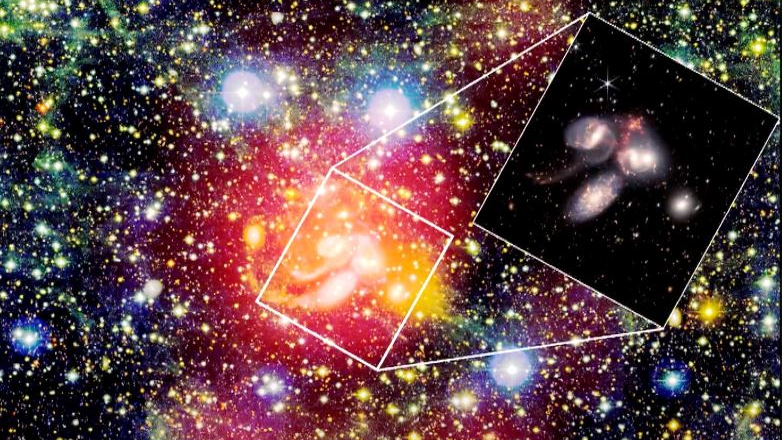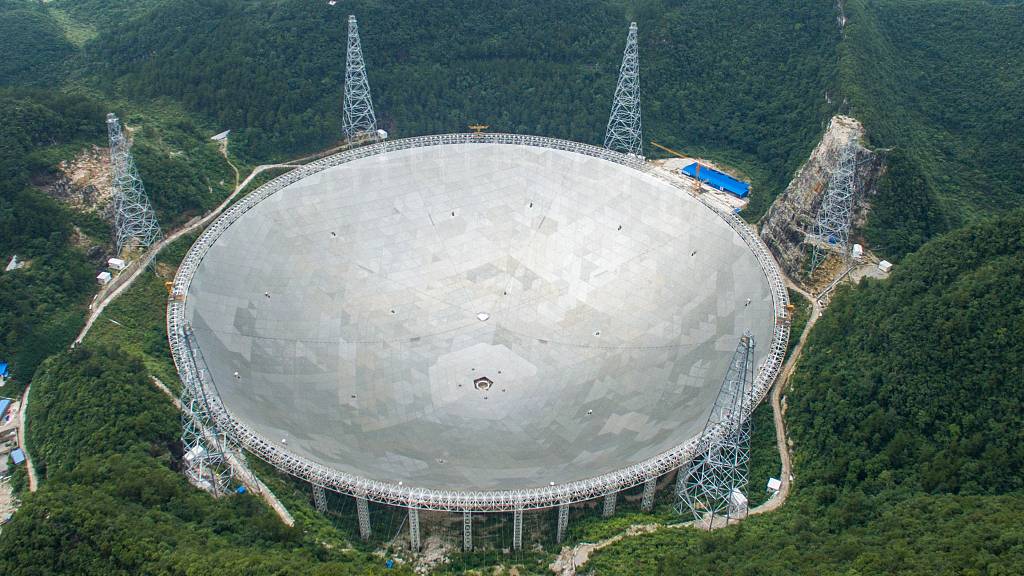
China's giant telescope was pointed towards the group of galaxies called Stephan's Quintet.
China's giant telescope was pointed towards the group of galaxies called Stephan's Quintet.
The largest atomic cloud in the universe has been discovered by China's 'Sky Eye' radio telescope.
An international team led by Chinese scientists have published their findings on this monumental cloud. It's made up of hydrogen atoms and measures two million light years across and is 20 times larger than our Milky Way galaxy.
How big is this?
A light year is a measure of distance, not time. It is the distance a beam of light, moving in a straight line, travels in one year.
To gauge the enormity of this, imagine the Earth's circumference (40,000 km), lay it out in a straight line, multiply its length by 7.5 and then place 31.6 million similar lines end to end. This comes to 9.5 trillion km... or one light year. So for the size of this atomic cloud, times this by two million.
The 'China Sky Eye,' also known as the Five-hundred-meter Aperture Spherical Radio Telescope (FAST), is the world's largest radio telescope, located in a natural basin in Guizhou in southwest China. Its great strength is its sensitivity to certain electromagnetic frequencies.
A group of galaxies known as Stephan's Quintet has been observed with results showing a mammoth low-density gaseous structure existed in a relatively far location from its center.
Stephan's Quintet is a visual grouping of five galaxies, of which four form the first compact galaxy group ever discovered. It was first spotted in 1877 in France and is the most studied of all the compact galaxy groups.
The study suggests there might be more large-scale, low-density atomic gas structures out in space. It could also help scientists understand the origins of galaxies and reveal similar more large-scale, low density atomic gas structures existing in space.

The 500-meter Aperture Spherical Radio Telescope fully opened in 2020. /CFP
The 500-meter Aperture Spherical Radio Telescope fully opened in 2020. /CFP
The researchers say this diffused feature was probably produced by tidal interactions in early stages of the formation of Stephan's Quintet. Diffusion occurs in liquids and gases when their particles collide randomly and spread out.
This discovery challenges the current understanding of how the galaxies and gaseous structure have evolved in the universe. Observing gas in the universe is considered crucial for studying astrophysics, with the origin of all celestial bodies in the universe related to atomic gas.
Lead author Xu Cong from the National Astronomical Observatories under the Chinese Academy of Sciences in Beijing suggests the colossal cloud is probably over a billion years old.
03:20

"Since its discovery 145 years ago, Stephan's Quintet has been extensively studied by various ground-based and space telescopes," Xu said.
"We wonder why it still exists at all, since atomic gas with low density should have been destroyed by the ultraviolet radiation in the cosmic background, according to current theories."
Images taken by NASA's James Webb Space Telescope were recently released showing a detailed image of Stephan's Quintet and how the interacting galaxies trigger star formation in each other and how gas in galaxies is being disturbed.